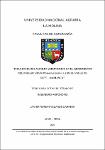Mostrar el registro sencillo del ítem
Influencia del manejo agronómico en el rendimiento del pallar Sieva (Phaseolus lunatus L.) en el valle de Supe – Barranca
| dc.contributor.advisor | Huaringa Joaquín, Amelia Wite | |
| dc.contributor.author | Velarde Carrion, Javier Roman | |
| dc.date.accessioned | 2024-04-01T16:05:29Z | |
| dc.date.available | 2024-04-01T16:05:29Z | |
| dc.date.issued | 2024 | |
| dc.identifier.uri | https://hdl.handle.net/20.500.12996/6386 | |
| dc.description | Universidad Nacional Agraria La Molina. Facultad de Agronomía. Departamento Académico de Fitotecnia | es_PE |
| dc.description.abstract | Con el objetivo de determinar el efecto de la densidad de siembra más apropiada y el uso de tutores en el rendimiento del pallar Sieva (Phaseolus lunatus L.) G25521 en el valle de Supe – Barranca, se planificó la presente investigación, bajo el diseño de bloques completamente al azar en el cual se estudió los factores densidad de siembra y el uso o no de tutores obteniéndose siete tratamientos y tres repeticiones. Los tratamientos están dados por el factor densidad de siembra en tres niveles: D1 con 93,750 plantas/ha con una distancia de 0.40 m entre planta y 0.80 m entre surcos; D2 con 125,000 plantas/ha con una distancia de 0.30 m entre plantas y 0.80 m entre surcos y D3 con 187,500 plantas/ha con una distancia de 0.20 m entre plantas y 0.80 entre surcos. La utilización de tutores o sin tutores de las plantas de pallar Sieva de crecimiento indeterminado en combinación con las tres densidades de siembra más el testigo (dado por la tecnología que maneja el productor) se obtuvo veintiún tratamientos. En la investigación se evaluaron las características agronómicas del pallar Sieva G25521 y el rendimiento de grano y sus componentes, así como los días a la floración. En este estudio se encontró que los tratamientos con menor densidad D1 tanto con tutor como sin tutor obtuvieron 1551.20 y 1186.54 kg/ha de rendimiento y superaron estadísticamente a los demás tratamientos. Por lo tanto, para las condiciones de baja fertilidad y limitado riego en el valle de Supe – Barranca, el rendimiento es aceptable cuando no se usa tutor. Además, los días a floración varió de 42 a 51 días y la madurez ocurrió a los 96 días, siendo el tratamiento más tardío el testigo con 105 días. Finalmente, se encontró una correlación positiva y alta entre rendimiento y el componente de vainas/planta. | es_PE |
| dc.description.abstract | In order to determine the effect of the most appropriate planting density and the use of tutors on the yield of Sieva pallar (Phaseolus lunatus L.) G25521 in the valley of Supe - Barranca, the present research was planned under a completely randomized block design in which the factors planting density and the use or not of tutors were studied, obtaining seven treatments and three replications. The treatments are given by the factor planting density at three levels: D1 with 93,750 plants/ha with a distance of 0.40 m between plants and 0.80 m between rows; D2 with 125,000 plants/ha with a distance of 0.30 m between plants and 0.80 m between rows and D3 with 187,500 plants/ha with a distance of 0.20 m between plants and 0.80 m between rows. The use of tutors or without tutors for Sieva pallar plants of indeterminate growth in combination with the three planting densities plus the control (given by the technology used by the producer) resulted in twenty-one treatments. The research evaluated the agronomic characteristics of Sieva G25521 pallar and grain yield and its components, as well as days to flowering. In this study it was found that the treatments with lower density D1 both with and without tutors obtained 1551.20 and 1186.54 kg/ha of yield and statistically outperformed the other treatments. Therefore, for the conditions of low fertility and limited irrigation in the Supe - Barranca valley, the yield is acceptable when no tutors are used. In addition, days to flowering ranged from 42 to 51 days and maturity occurred at 96 days, with the control being the latest treatment with 105 days. Finally, a positive and high correlation was found between yield and the pods/plant component. | es_PE |
| dc.format | application/pdf | es_PE |
| dc.language.iso | spa | es_PE |
| dc.publisher | Universidad Nacional Agraria La Molina | es_PE |
| dc.rights | info:eu-repo/semantics/openAccess | es_PE |
| dc.rights.uri | https://creativecommons.org/licenses/by-nc-nd/4.0/ | es_PE |
| dc.subject | Phaseolus lunatus L. | es_PE |
| dc.title | Influencia del manejo agronómico en el rendimiento del pallar Sieva (Phaseolus lunatus L.) en el valle de Supe – Barranca | es_PE |
| dc.type | info:eu-repo/semantics/bachelorThesis | es_PE |
| thesis.degree.discipline | Agronomía | es_PE |
| thesis.degree.grantor | Universidad Nacional Agraria La Molina. Facultad de Agronomía | es_PE |
| thesis.degree.name | Ingeniero Agrónomo | es_PE |
| dc.subject.ocde | https://purl.org/pe-repo/ocde/ford#4.01.07 | es_PE |
| renati.author.dni | 15711565 | es_PE |
| dc.publisher.country | PE | es_PE |
| dc.type.version | info:eu-repo/semantics/publishedVersion | es_PE |
| renati.advisor.orcid | https://orcid.org/0000-0001-5305-9514 | es_PE |
| renati.advisor.dni | 06564295 | es_PE |
| renati.type | https://purl.org/pe-repo/renati/type#tesis | es_PE |
| renati.level | https://purl.org/pe-repo/renati/level#tituloProfesional | es_PE |
| renati.discipline | 811036 | es_PE |
| renati.juror | Vega Cadima, Hugo | |
| renati.juror | Salinas Barreto, Luis | |
| renati.juror | Chiappe Vargas, Luis |
Ficheros en el ítem
Este ítem aparece en la(s) siguiente(s) colección(ones)
-
AGR-FT Tesis [267]





